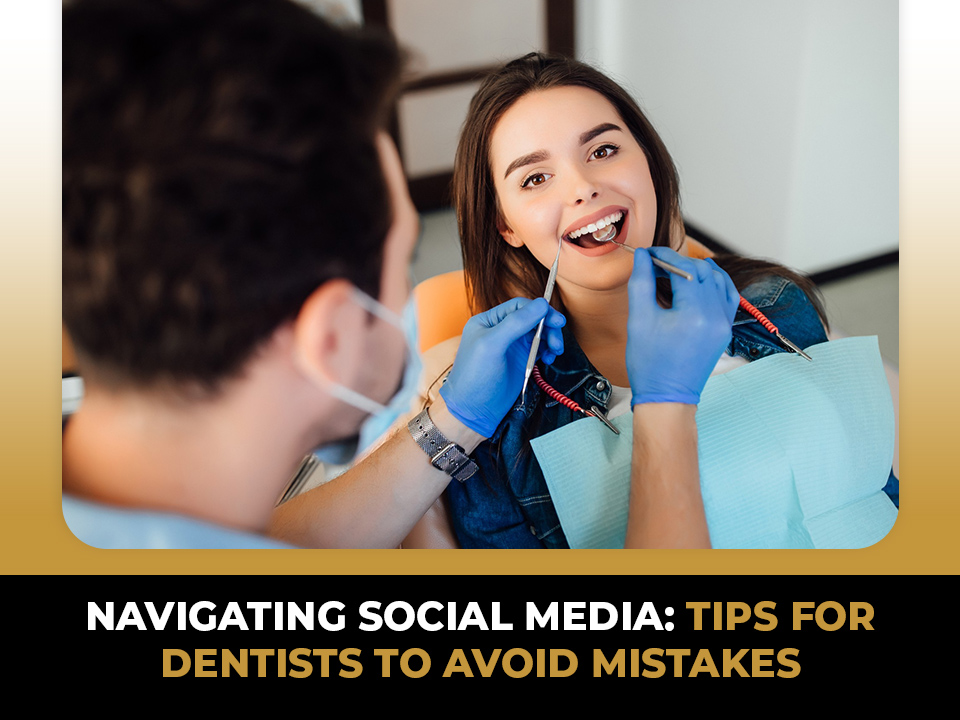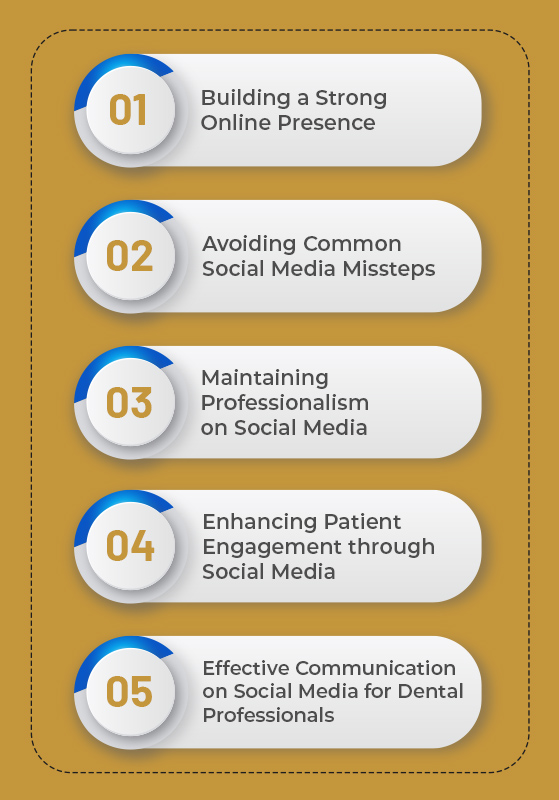
Navigating Social Media: Tips for Dentists to Avoid Mistakes
In today’s digital age, social media has become an increasingly important tool for dentists to connect with patients and build their brands. However, with the potential for missteps and reputational damage, dentists must be mindful of common mistakes made on social media. This blog aims to provide practical tips for dentists to navigate social media, avoid common mistakes, and build a strong online presence that attracts and retains patients. By the end of this blog, you’ll clearly understand how to use social media to your advantage and avoid costly missteps that could harm your practice.
As a dentist, mistakes can significantly affect your practice, reputation, and, most importantly, your patients’ oral health. Here are some tips to help you avoid mistakes in your dental practice.
Tips for Dentists to Avoid Mistakes

1. Building a Strong Online Presence
In today’s digital age, having a strong online presence is crucial for any healthcare practice. Social media has become a powerful tool to reach patients, build relationships, and establish trust. One of the critical elements of building a successful social media strategy is consistency and branding. Consistency means posting regular content that aligns with your brand and your practice’s values. Branding is your visual and messaging identity across your social media channels.
Consistent branding helps your dental practice stand out and establishes recognition among your target audience. It also ensures that your messaging is clear and aligned with your practice’s values. This consistency builds trust and credibility among your followers, which is essential for building long-term relationships.
Tips for Creating a Professional and Engaging Social Media Profile
Creating a professional and engaging social media profile is essential to attract and retain patients. Here are some tips to help you create a strong social media profile:
- Use high-quality visuals that reflect your practice’s branding and messaging.
- Write a compelling bio that accurately describes your dental practice and services.
- Use keywords relevant to your practice to help patients find you more easily.
- Include a call-to-action that encourages patients to book appointments or visit your website.
- Engage with your followers by responding to comments and messages promptly.
- Keep your profile up-to-date with the latest information about your practice.
Best Practices for Posting Content that Resonates with Patients
Creating content that resonates with patients is essential to building engagement and trust on social media. Here are some best practices for posting content that resonates with patients:
- Use a mix of different types of content, including educational posts, news updates, and personal stories.
- Use visuals like images and videos to make your posts more engaging.
- Use a conversational tone to make your content more relatable to patients.
- Use patient testimonials and success stories to build social proof and credibility.
- Keep your content informative, relevant, and valuable to your followers.
- Use hashtags to increase your reach and visibility on social media.
By following these best practices, you can create a strong social media strategy that resonates with your patients and helps you build a successful online presence.
Read More: 6 EASY WAYS TO INCREASE BRAND EXPOSURE
2. Avoiding Common Social Media Missteps
While social media can be an effective tool for dental practices to connect with patients and build relationships, it can also be a double-edged sword. One mistake can cause significant damage to your reputation and credibility. Here are some common social media missteps to avoid:
1. Oversharing Personal Information
Sharing personal information on social media can blur professional and personal boundaries and compromise patient confidentiality. Patients expect dentists to maintain high standards of privacy and confidentiality. Avoid sharing personal information, such as your address, phone number, or opinions on sensitive topics.
2. Posting Inappropriate or Controversial Content
Posting inappropriate or controversial content can create a negative impression of your practice and turn off patients. Avoid posting content that is offensive, discriminatory, or defamatory. Before posting anything, consider how different audiences might perceive it and how it aligns with your practice’s values and messaging.
3. Neglecting to Monitor Reviews and Comments
Reviews and comments can make or break a healthcare practice’s reputation. Neglecting to monitor reviews and comments can cause harm to your dental practice’s online presence. Responding to negative reviews and comments promptly and professionally shows that you care about your patients’ feedback and are committed to addressing their concerns.
Tips for Avoiding These Missteps
Here are some tips for avoiding social media missteps:
- Develop a social media policy that outlines what is and isn’t acceptable to post on your practice’s social media channels.
- Train your staff on using social media professionally and ensure they understand the importance of maintaining patient confidentiality and privacy.
- Plan your content beforehand and get approval from multiple team members before posting.
- Use a scheduling tool to plan and schedule posts in advance, giving you time to review them and make any necessary edits.
- Monitor reviews and comments regularly and respond to them promptly and professionally.
Following these tips and avoiding common social media missteps can build a positive online presence, foster strong relationships with patients, and achieve long-term success.
Read More: Final Journey of Steve Harwell: Reflecting on a Rock Legacy
3. Maintaining Professionalism on Social Media
Social media has become a critical platform for dental practices to connect with patients, build relationships, and share information. However, it is essential to maintain professionalism on social media to avoid damaging your reputation and credibility. Here are some strategies for maintaining professionalism on social media:
Communicating with Patients Online in a Professional Manner
Communicating with patients online requires a different approach than in-person communication. Here are some tips for communicating with patients online in a professional manner:
- Use a friendly and conversational tone but maintain a professional demeanour.
- Respond to messages and comments promptly and with empathy.
- Avoid using medical jargon or acronyms that patients might not understand.
- Keep your responses concise and to the point.
- Use proper grammar and spelling to maintain professionalism.
Strategies for Managing Negative Feedback or Reviews
Negative feedback or reviews can happen to any healthcare practice, and how you handle them can significantly affect how patients perceive you. Here are some strategies for managing negative feedback or reviews:
- Respond to the feedback or review promptly and with empathy.
- Apologize for any negative experience the patient may have had.
- Offer a resolution or solution to the patient’s concern.
- Take the conversation offline if necessary to protect the patient’s privacy.
- Use the feedback or review to improve your practice’s services.
Best Practices for Addressing Patient Concerns on Social Media
Addressing patient concerns on social media is essential to maintain patient satisfaction and trust in your practice. Here are some best practices for addressing patient concerns on social media:
- Respond to patient concerns professionally.
- Acknowledge the patient’s concern and empathize with their situation.
- Provide a clear explanation of the issue and a solution.
- Follow up with the patient to ensure their concern has been resolved.
By following these strategies and best practices, dental practices can maintain professionalism on social media and build trust and credibility with patients.
4. Enhancing Patient Engagement through Social Media
Social media allows dental practices to engage with patients, build relationships, and share valuable information and resources. Here are some tips for enhancing patient engagement through social media:
Tips for Building Relationships with Patients on Social Media
Building relationships with patients on social media requires a different approach than traditional marketing strategies. Here are some tips for building relationships with patients on social media:
- Be consistent in your messaging and branding to establish a recognizable and trustworthy online presence.
- Respond to comments and messages promptly and with empathy to show that you care about your patients.
- Share relevant and valuable content with your patients, such as health tips, news updates, and educational resources.
- Use a friendly and conversational tone to make patients feel comfortable engaging with your practice.
- Create a sense of community by engaging with patients and encouraging them to interact with each other.
Using Social Media to Share Valuable Information and Resources
Social media provides healthcare practices a platform to share valuable information and resources with patients. Here are some ways to use social media to share valuable information and resources:
- Share educational resources, such as infographics, videos, and blog posts, that provide valuable information about health and wellness.
- Share news updates and research findings related to your practice’s expertise.
- Use social media to promote events, such as health fairs and workshops, relevant to your patients.
- Provide links to helpful resources, such as patient portals and online support groups.
Encouraging Patient Participation through User-Generated Content
Encouraging patient participation through user-generated content can enhance patient engagement and build community. Here are some ways to encourage patient participation through user-generated content:
- Encourage patients to share their stories and experiences on social media.
- Ask patients to share their thoughts and opinions on health-related topics.
- Use polls and surveys to gather feedback and opinions from patients.
- Highlight patient success stories and accomplishments to motivate and inspire others.
By following these tips and strategies, dentists can enhance patient engagement through social media, build relationships, and improve patient satisfaction.
5. Effective Communication on Social Media for Dental Professionals
As a dental professional, clear and concise communication is critical when engaging with patients on social media platforms. In a fast-paced world where attention spans are short, it’s essential to communicate in a manner that captures patients’ attention quickly and effectively. Use clear and concise language that is easy to understand, and avoid using complex dental jargon.
Tips for Effective Messaging and Calls-to-Action
When crafting messages and calls-to-action on social media, dental professionals should consider the following tips:
- Know your audience: Understanding patients’ needs and preferences is essential when crafting messages and calls to action that resonate with them.
- Keep it simple: Use short, easy-to-read sentences to communicate your message.
- Use visuals: Incorporate images or videos into your messaging to make it more engaging and visually appealing.
- Make it actionable: Use clear and specific calls to action that tell patients what to do next, such as “schedule an appointment” or “learn more.“
Strategies for Using Social Media to Communicate with Patients Outside the Office
Social media can be an effective tool for dental professionals to communicate with patients outside the office. Consider the following strategies:
- Respond to patient inquiries: Respond promptly to patient questions and inquiries, showing that you value their time and are committed to their care.
- Share educational content: Share informative content on oral health and dental care that patients may find helpful.
- Celebrate patient successes: Share patient success stories, such as before-and-after photos, to showcase your work and build trust with potential patients.
Conclusion
In summary, dental professionals can effectively use social media by communicating clearly and concisely, using engaging visuals, and making their messaging actionable. They can also use social media to communicate with patients outside the office by responding to inquiries, sharing educational content, and celebrating patient successes.
By following these tips, dental professionals can build a strong online presence, attract new patients, and retain existing ones. With the right approach, social media can be an effective tool for dental practices to connect with patients and communicate their value.


